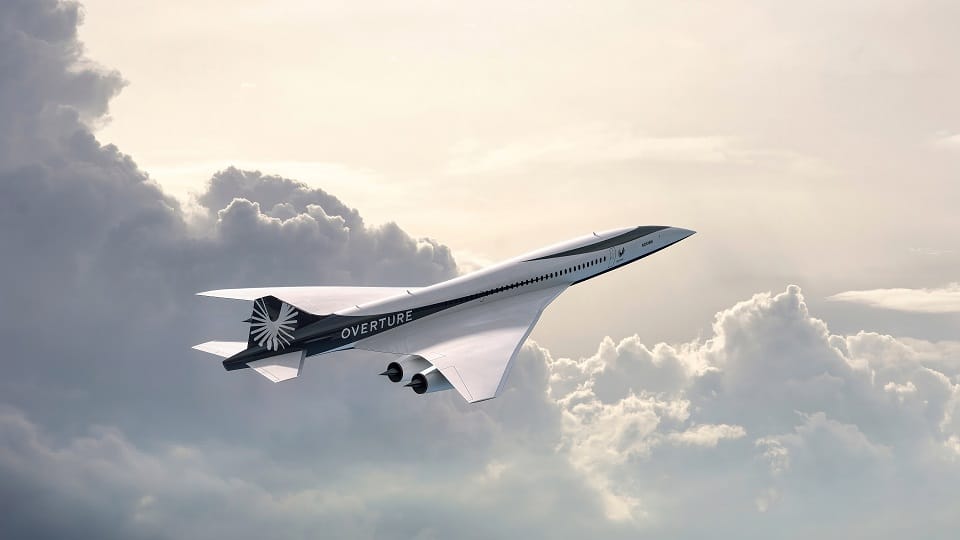Aerospace
This 65-seat Boom passenger jet travels at fighter jet speeds.
The passenger jet can travel at mach 1.7, which is comparable to the fighter jet’s speed. There was a period when Concorde Flight reinvented itself using cutting-edge aviation technology. #boom

The passenger jet can travel at mach 1.7, which is comparable to the fighter jet’s speed. There was a period when Concorde Flight reinvented itself using cutting-edge aviation technology. One of the most eagerly awaited aircraft manufacturers, Boom Supersonic, is set to deploy its first aircraft in 2029. The majority of the airlines who liked the idea have expressed interest in and agreed to purchase aircraft, including United Airlines as of right now.
Concorde supersonic flight (1976 – 2003)
The Concorde was a tailless aircraft with an ogival delta wing, a drooping nose for landing visibility, and a narrow fuselage that allows for seating for 92 to 128 passengers four abreast. Four Rolls-Royce/Snecma Olympus 593 turbojets with variable intake ramps and reheat for takeoff and supersonic speed acceleration power it. It was the first airliner to have analogue fly-by-wire flight controls, and it was made of aluminum. At an altitude of 60,000 feet, the aircraft could maintain a supercruise up to Mach 2.04 (2,167 km/h; 1,170 kn).
Overture supersonic flight (2029)
Today, the firm developing the fastest commercial airliner in the world unveiled Overture’s improved design and announced a new partnership with Northrop Grumman to create special mission variants of the aircraft.
This aircraft has an extraordinary range of about 4,250 nautical miles and can travel at a speed of Mach 1.7 while carrying up to 65–80 passengers and travelling at double the speed of existing aircraft. In addition, this aircraft can be run entirely on sustainable fuel (SAF).
The company showcased its development phases at the Farnborough airshow, including five wind tunnel tests, 26 million cores of simulated software design, and numerous other testings.
Silent features of Overture.
Four strong, wing-mounted engines will power Overture, allowing the aircraft to travel at Mach 1.7 over water and just under Mach 1 on land. The four-engine configuration significantly lowers expenses for airline operators while reducing noise.
Overture will feature the first automated noise reduction system ever used during takeoff. Without using afterburners, the airliner will fly while adhering to the same tight noise regulations as the most recent subsonic aircraft.
The fuselage of Overture has a bigger diameter at the front and a smaller diameter at the back. This method of design has been used by Boom to reduce drag and increase fuel efficiency at supersonic speeds.
The wings of the aircraft are shaped to improve handling in subsonic and transonic flight as well as supersonic performance.
The majority of Overture’s construction will be made of carbon composite materials, which are more thermally stable, stronger, and lighter than typical metal construction.
Overture Specifications:
- Cruise speed: Mach 1.7 supersonic, Mach 0.94 subsonic
- Range: 4,250nm with full payload
- Passengers: 65–80
- Exterior Dimensions: Length: 201 feet, Wingspan: 106 feet, Height: 36 feet
- Interior Dimensions: 79 feet long, up to 6.5 feet height at aisle
- Airframe: composite fuselage, wing, vertical, and horizontal
- Wing: gull with digital leading and trailing edge flap control
- Flight controls: 4x redundant digital fly-by-wire on 2 LRUs
- Powerplant: 4x medium-bypass 100% SAF-compatible turbofan
- Airport Community noise: ICAO Chapter 14 / FAA Stage 5

Aerospace
When Ratan Tata was denied entry to the airfield at the Aero India show, he waited

During our visit to Aero India 2019, we had the unexpected opportunity to see Ratan Tata at the event, which was a thrilling moment for us. However, there was a surprising hiccup when the security staff didn’t allow him to enter due to a lack of a security pass.
Despite this, he remained calm and patiently waited for about 20 minutes until a member of the Tata team brought him the required pass, after which he calmly proceeded inside. It was a humbling sight, showcasing his composed demeanor even in such situations.
Ratan Tata ji is not only a renowned industrialist but also a trained pilot, holding a pilot’s license. In 2007, he became the first Indian civilian to fly the F-16 Falcon during the Aero India show in Bangalore—a proud moment for the nation.
His passion for aviation extended beyond flying, as he played a key role in shaping India’s aerospace industry. Under his leadership, Tata ventured into manufacturing and maintaining aerospace components while upholding its legacy of quality. Notably, Tata’s collaboration with Airbus to develop and manufacture the C295 aircraft is a testament to its growing influence in the sector.
-

 Aviation2 months ago
Aviation2 months agoMicrosoft Flight Simulator Raises $3 Million to Bring Back the An-225 Mriya
-

 Airlines2 months ago
Airlines2 months agoQatar Citizens Can Travel to the United States Without a Visa
-

 Aviation2 months ago
Aviation2 months agoQatar Airways bans these new Electronic Devices on plane
-

 Airlines2 months ago
Airlines2 months agoJapan Airlines Rolls Out Free Domestic Flights to International Passengers
-

 Defence2 months ago
Defence2 months agoWhich Country Has the Largest Fleet of Fighter Aircraft?
-

 Airport2 months ago
Airport2 months agoWestern Sydney Airport Welcomes Its First Plane After 6 Years of construction
-

 Airlines4 days ago
Airlines4 days agoDAMAC Air: Dubai’s New Luxury Airline Offers Free Flights for Registration
-

 Aviation2 months ago
Aviation2 months agoDid you know ? Once Boeing 747 carried 1088 passenger in 1991








